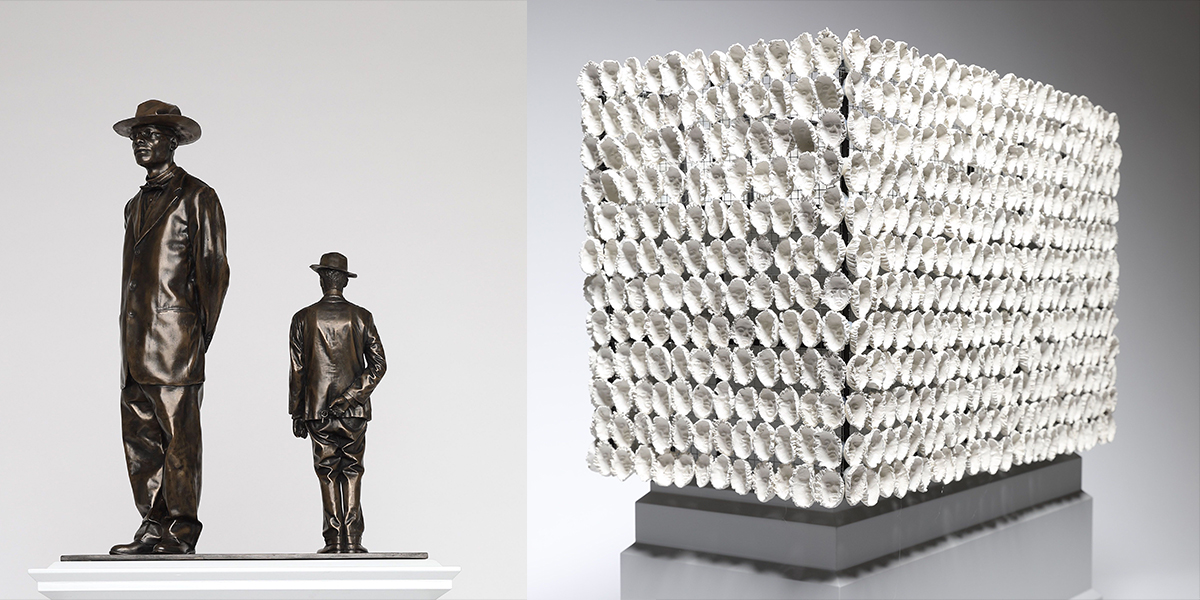Samson Kambalu and Teresa Margolles have been announced as the next two artists chosen for the Fourth Plinth commission in Trafalgar Square. They were picked from a shortlist which included Nicole Eisenman, Goshka Macuga, Ibrahim Mahama and Paloma Varga Weisz.
Samson Kambalu’s Antelope restages a photograph of Baptist preacher and pan-Africanist (belief in a unified African nation) John Chilembwe and European missionary John Chorley as a sculpture.
The photograph was taken in 1914 at the opening of Chilembwe’s new church in Nyasaland, now Malawi. Chilembwe has his hat on, defying the colonial rule that forbade Africans from wearing hats in front of white people. A year later, he led an uprising against colonial rule. Chilembwe was killed and his church, which had taken years to build, was destroyed by the colonial police.
On the plinth, Chilembwe is larger than life, while Chorley is life-size. By increasing his scale, the artist elevates Chilembwe and his story, revealing the hidden narratives of underrepresented peoples in the history of the British Empire in Africa and beyond.
Born in Malawi in 1975, today, he lives and works in Oxford. His largest solo exhibition to date, Samson Kambalu: New Liberia, runs at Modern Art Oxford until September 5 2021.
Samson Kambalu said: Kambalu works in various media, including site-specific installation, video, performance and literature. His work is autobiographical and approaches art as an arena for critical thought and sovereign authority’s activities. “Antelope on the Fourth Plinth was ever going to be a litmus test for how much I belong to British society as an African and a cosmopolitan. This commission fills me with excitement and joy.”
Teresa Margolles 850 Improntas (850 Imprints) features casts of the faces of 850 trans people from London and around the world. She works closely with this marginalised community that sometimes is unable to access social care. The ‘life masks’ will be arranged around the plinth in the form of a Tzompantli, a skull rack from Mesoamerican civilisations (an area covering Central Mexico to northern Costa Rica). It was used to display the remains of war captives or sacrifice victims.
The casts will be created together with trans communities. Plaster will be applied directly onto their faces. As such, not only will their features be recorded, the material will also become infused with their hair and skin cells. London’s weather means the work will inevitably deteriorate and fade away, leaving a kind of anti-monument behind. This will continue to command attention and put a spotlight on participants whose lives are often overlooked.
Born in Culiacán, Sinaloa, Mexico, in 1963, today she lives and works in Mexico City. Margolles is a conceptual artist, photographer, videographer and performance artist. Her works investigates the social and aesthetic dimensions of conflict. She creates sculptural installations, photographs, films and performances imbued with material traces of death.
Teresa Margolles said: “This tzompantli is an exercise in trust and collective work. It is necessary to visualise and signal transfemenicide. The work brings together 850 transgender people worldwide, signalling the murder that occurs primarily in Latin America. This return to the human, to the primal, to the skin as a borderline and fundamental principle of acceptance proposes an awareness of the freedom and rights of every human being.
This year marks the sixth anniversary of the homicide of Karla, a transgender woman who was engaged in prostitution. She was murdered on December 22, 2016, in Ciudad Juárez, Chihuahua, Mexico. This commission is for her and for all the others who were murdered. But above all, for trans people who are still living.”

